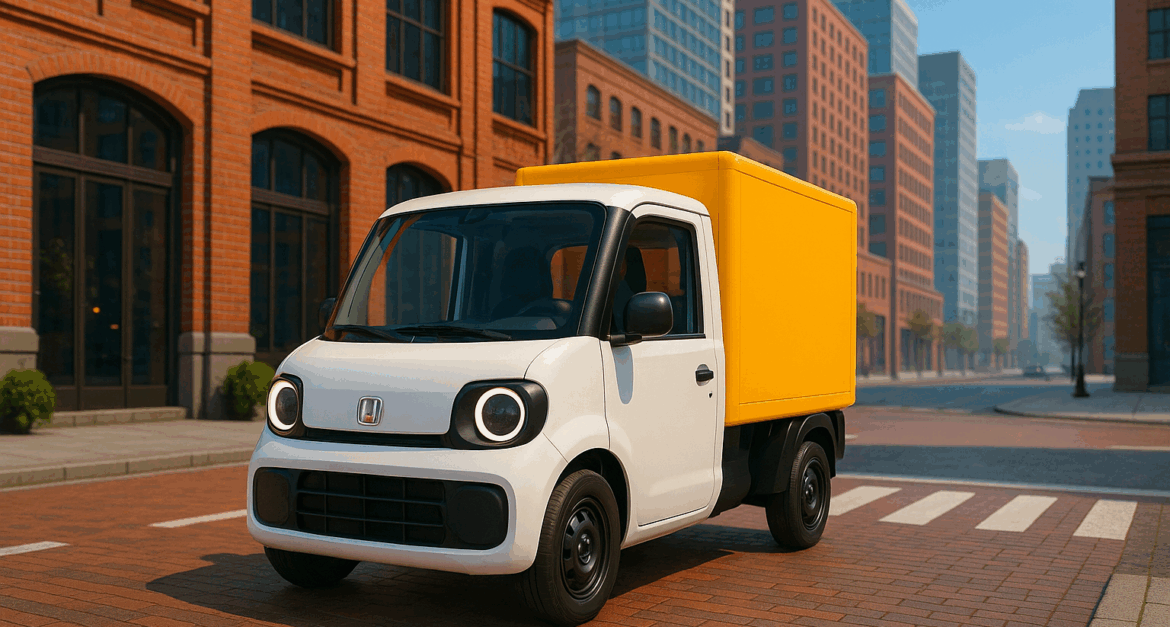
Introduction: A Small Vehicle, A Big Disruption
In July 2025, Honda unveiled Fastport—a compact, modular, fully electric quadricycle built specifically for urban last-mile delivery. Quiet, compact, battery-swappable, and lane-friendly, this vehicle may look small, but its implications for logistics are massive.
Why does this matter?
Because U.S. cities are choking on congestion, tightening emissions regulations, and raising operating costs for traditional delivery vans. As consumer expectations for fast, eco-friendly delivery increase, the logistics world is overdue for innovation.
Fastport might just be it.
At AMB Logistic, we’ve long recognized that the future of freight doesn’t always ride on 18 wheels. In cities, the smartest freight moves on smaller, faster, cleaner platforms—and Fastport could be the most scalable shift yet.
What Is Honda Fastport? A Quick Breakdown
Fastport is Honda’s response to three converging problems:
- Urban traffic gridlock
- Last-mile inefficiency
- Environmental regulation pressure
Core Features:
- Electric quadricycle frame (fits in standard bike lanes and tight alleys)
- Modular cargo pod system (easy loading/unloading, courier transfer)
- Swappable battery (reduces downtime to minutes)
- Built-in driver safety tech (proximity sensors, braking alerts, speed limiter)
The vehicle is designed for dense city environments like New York, Chicago, San Francisco, and Washington, D.C.—where maneuverability matters as much as mileage.
Why This Changes the Urban Logistics Game
1. Bypassing Congestion
Fastport can access bike lanes, delivery alleys, and parking-restricted zones. This sidesteps traditional curb congestion and speeds up delivery times in high-density areas.
2. Beating Emissions Restrictions
Cities like New York, Seattle, and Los Angeles are rolling out low-emission zones and EV-only mandates for commercial deliveries. Fastport meets the criteria with zero tailpipe emissions.
3. Lower Operational Costs
Compared to traditional vans:
- Insurance is cheaper
- Charging is faster
- Maintenance is minimal (no oil, fewer moving parts)
- Labor flexibility is greater (requires only a basic operator’s license)
For companies delivering e-commerce, pharmaceuticals, food, and documents, this translates into lower costs and smoother last-mile scalability.
The Competitive Advantage for Logistics Firms
This isn’t just a product—it’s a logistics strategy.
1. Modular Routing
Use traditional trucks to drop Fastport units into downtown staging areas. Drivers then complete the last mile using the quadricycle—saving time, parking headaches, and fuel.
2. Courier Swapping
Fastport’s cargo pods can be transferred between riders or pickup stations. Think Uber Eats + warehouse transfer for B2B freight.
3. Live Rebalancing
Reroute pods mid-day using Fastport’s GPS integration—perfect for dynamic dispatch and SLA pressure scenarios.
Challenges to Widespread Adoption
Like any innovation, Fastport faces real barriers:
- Infrastructure Readiness: Not all cities allow quadricycles in traffic or bike lanes yet.
- Scalability Needs: Fastport fleets must integrate with traditional TMS platforms to avoid siloed dispatching.
- Training & Fleet Ops: Companies will need to manage a mixed vehicle environment—adding complexity to scheduling and maintenance.
But as EV incentives expand and urban restrictions tighten, these are solvable problems—and early adopters will lead the pack.
How AMB Logistic Is Preparing
At AMB Logistic, we’re actively exploring urban EV partnerships in pilot cities and working on Fastport readiness in key metro markets.
Our strategy includes:
- Partnering with Fastport-certified operators
- Offering modular last-mile integration for retail and healthcare clients
- Integrating Fastport tracking and routing into our core TMS
- Educating clients on carbon reporting benefits and urban compliance advantages
What Shippers Should Do Now
If your business relies on urban deliveries, this is the time to get ahead of the shift.
1. Map Your Metro Volume
Audit your top delivery ZIP codes in cities like NYC, SF, LA, Chicago—where Fastport can offer the biggest advantage.
2. Prepare for Mixed-Mode Logistics
Design workflows that accommodate large truck drops and compact final-mile handoffs.
3. Track Emissions Compliance
Use Fastport’s adoption to improve ESG metrics, lower Scope 3 emissions, and preempt green shipping regulations.
4. Talk to Your 3PL
Ask how your logistics partners are preparing for EV integration, emissions reporting, and zone-based delivery restrictions.
Conclusion: The Smallest Vehicle Could Drive the Biggest Change
Fastport may be small, but its launch is a turning point for city freight. The combination of efficiency, sustainability, and flexibility makes it one of the most important delivery innovations in years.
As cities get denser, roads get tighter, and emissions get regulated, logistics providers will need to evolve—quickly.
At AMB Logistic, we’re already rolling out strategies for that next era. Whether you need to rethink routing, redesign final-mile flows, or stay compliant in a fast-changing urban environment, we’re here to help you move faster, greener, and smarter.
Contact AMB Logistic
📧 info@amblogistic.us
🌐 www.amblogistic.us
📞 +1 (888) 538-6433
Tags: Fastport, Honda Electric Delivery Vehicle, Urban Last-Mile, Sustainable Logistics, Quadricycle Freight, Modular Delivery, City Freight Solutions, Green Shipping, EV Logistics, AMB Final Mile Innovation




